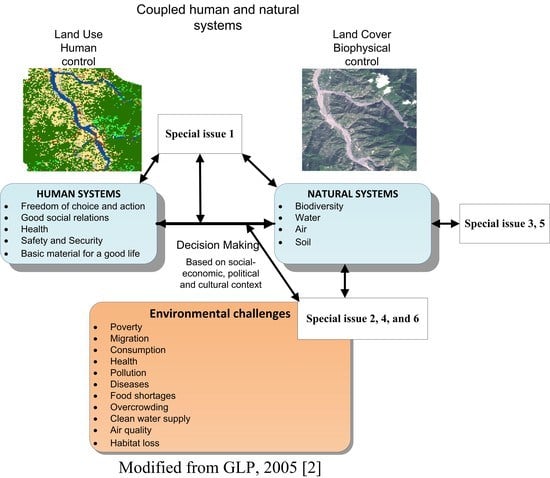Review of Special Issues in the First Half of 2016
References
- Anderson, S.H.; Beiswenger, R.E.; Purdom, P.W. Environmental Science, 4th ed.; Macmillan Publishing Company: Columbus, GA, USA, 1993; p. 21. [Google Scholar]
- Young, B.; Noone, K.; Steffen, W. Science Plan and Implementation Strategy; IGBP Report No. 53/IHDP Report No. 19; IGBP Secretariat, Global Land Project (GLP): Stockholm, Sweden, 2005; p. 64. [Google Scholar]
- Liu, J.; Dietz, T.; Carpenter, S.R.; Alberti, M.; Folke, C.; Moran, E.; Pell, A.N.; Deadman, P.; Kratz, T.; Lubchenco, J. Complexity of coupled human and natural systems. Science 2007, 317, 1513–1516. [Google Scholar] [CrossRef] [PubMed]
- Chiang, L.-C.; Lin, Y.-P.; Huang, T.; Schmeller, D.S.; Verburg, P.H.; Liu, Y.-L.; Ding, T.-S. Simulation of ecosystem service responses to multiple disturbances from an earthquake and several typhoons. Landsc. Urban Plan. 2014, 122, 41–55. [Google Scholar] [CrossRef]
- Lin, Y.-P. Environments: A New Cutting-Edge International and Interdisciplinary Scholarly Open Access Journal. Environments 2014, 1, 1–3. [Google Scholar] [CrossRef]
- Special Issue “Land Use Change in the Changing Environment”. Available online: https://0-www-mdpi-com.brum.beds.ac.uk/journal/environments/special_issues/land-changing (accessed on 17 June 2016).
- Kabisch, N.; Qureshi, S.; Haase, D. Human-environment interactions in urban green spaces—A systematic review of contemporary issues and prospects for future research. Environ. Impact Assess. Rev. 2015, 50, 25–34. [Google Scholar] [CrossRef]
- Uphoff, N.; Dazzo, F.B. Making Rice Production More Environmentally-Friendly. Environments 2016, 3, 12. [Google Scholar] [CrossRef]
- Crossman, N.D.; Bryan, B.A.; de Groot, R.S.; Lin, Y.P.; Minang, P.A. Land science contributions to ecosystem services. Curr. Opin. Environ. Sustain. 2013, 5, 509–514. [Google Scholar] [CrossRef]
- Lin, Y.P.; Hong, N.M.; Chiang, L.C.; Liu, Y.L.; Chu, H.J. Adaptation of land-use demands to the impact of climate change on the hydrological processes of an urbanized watershed. Int. J. Environ. Res. Public Health 2012, 9, 4083–4102. [Google Scholar] [CrossRef] [PubMed]
- Special Issue “Climate Change and Environmental Risk: Environmental Economics, Political Ecology and Socio-Environmental Management 2016”. Available online: https://0-www-mdpi-com.brum.beds.ac.uk/journal/environments/special_issues/climate_risk_2016 (accessed on 17 June 2016).
- Montzka, S.A.; Dlugokencky, E.J.; Butler, J.H. Non-CO2 greenhouse gases and climate change. Nature 2011, 476, 43–50. [Google Scholar] [CrossRef] [PubMed]
- Special Issue “Uncertainty in PVA (Population Viability Analysis) Assessments”. Available online: https://0-www-mdpi-com.brum.beds.ac.uk/journal/environments/special_issues/Population-Viability-Analysis (accessed on 17 June 2016).
- Elith, J.E.; Graham, C.H. Do they? How do they? Why do they differ? On finding reasons for differing performances of species distribution models. Ecography 2009, 32, 66–77. [Google Scholar] [CrossRef]
- Barbet-Massin, M.; Jiguet, F.; Albert, C.H.; Thuiller, W. Selecting pseudo-absences for species distribution models: how, where and how many? Methods Ecol. Evol. 2012, 3, 327–338. [Google Scholar] [CrossRef]
- Lin, Y.P.; Deng, D.; Lin, W.C.; Lemmens, R.; Crossman, N.D.; Henle, K.; Schmeller, D.S. Uncertainty analysis of crowd-sourced and professionally collected field data used in species distribution models of Taiwanese moths. Biol. Conserv. 2015, 181, 102–110. [Google Scholar] [CrossRef]
- Brook, B.W.; O’Grady, J.J.; Chapman, A.P.; Burgman, M.A.; Akçakaya, H.R.; Frankham, R. Predictive accuracy of population viability analysis in conservation biology. Nature 2000, 404, 385–387. [Google Scholar] [CrossRef] [PubMed]
- Special Issue “Data-Modelling Applications in Water System Management”. Available online: https://0-www-mdpi-com.brum.beds.ac.uk/journal/environments/special_issues/Data-Modelling-Applications (accessed on 17 June 2016).
- Lin, Y.P.; Lin, W.C.; Wu, W.Y. Uncertainty in Various Habitat Suitability Models and Its Impact on Habitat Suitability Estimates for Fish. Water 2015, 7, 4088–4107. [Google Scholar] [CrossRef]
- Gaur, S.; Ch, S.; Graillot, D.; Chahar, B.R.; Kumar, D.N. Application of artificial neural networks and particle swarm optimization for the management of groundwater resources. Water Resour. Manag. 2013, 27, 927–941. [Google Scholar] [CrossRef]
- Special Issue “Mountains in the Changing World”. Available online: https://0-www-mdpi-com.brum.beds.ac.uk/journal/environments/special_issues/mountains (accessed on 17 June 2016).
- Koner, C.; Ohsawa, M.; Spehn, E.; Berge, E.; Bugmann, H.; Groombridge, B.; Hamilton, L.; Hofer, T.; Ives, J.; Jodha, N.; Messerli, B.; Pratt, J.; Price, M.; Reasoner, M.; Rodgers, A.; Thonell, J.; Yoshino, M. References. In Ecosystems and Human Well-Being: Current State and Trends; Hassan, R., Scholes, R., Ash, N., Eds.; Island Press: Washington, DC, USA, 2005; Volume 1, pp. 681–716. [Google Scholar]
- Harrison, P.A.; Vandewalle, M.; Sykes, M.T.; Berry, P.M.; Bugter, R.; de Bello, F.; Feld, C.K.; Grandin, U.; Harrington, R.; Haslett, J.R.; et al. Identifying and prioritising services in European terrestrial and freshwater ecosystems. Biodivers. Conserv. 2010, 19, 2791–2821. [Google Scholar] [CrossRef]
- Schroöter, D.; Cramer, W.; Leemans, R.; Prentice, I.C.; Arauújo, M.B.; Arnell, N.G.; Bondeau, A.; Bugmann, H.; Carter, T.; de la Vega-Leinert, A.C.; et al. Ecosystem service supply and human vulnerability to global change in Europe. Science 2005, 310, 1333–1337. [Google Scholar] [CrossRef] [PubMed]
- Briner, S.; Elkin, C.; Huber, R.; Grêt-Regamey, A. Assessing the impacts of economic and climate changes on land-use in mountain regions: A spatial dynamic modeling approach. Agric. Ecosyst. Environ. 2012, 149, 50–63. [Google Scholar] [CrossRef]
- Special Issue “Consideration of Ecosystem Services and Function for Sustainable Water Use”. Available online: https://0-www-mdpi-com.brum.beds.ac.uk/journal/environments/special_issues/ecosystem_service_water_use (accessed on 17 June 2016).
- Millennium Ecosystem Assessment. 2005 Millennium Ecosystem Assessment Ecosystems and Human Well-Being: Synthesis; Island Press: Washington, DC, USA, 2005. [Google Scholar]
- Liu, S.; Crossman, N.D.; Nolan, M.; Ghirmay, H. Bringing ecosystem services into integrated water resources management. J. Environ. Manag. 2013, 129, 92–102. [Google Scholar] [CrossRef] [PubMed]
- UNEP. 2012 UNEP Status Report on the Application of Integrated Approaches to Water Resources Management. Available online: http://www.unwater.org/documents.html (accessed on 17 June 2016).


© 2016 by the author; licensee MDPI, Basel, Switzerland. This article is an open access article distributed under the terms and conditions of the Creative Commons Attribution (CC-BY) license (http://creativecommons.org/licenses/by/4.0/).
Share and Cite
Lin, Y.-P. Review of Special Issues in the First Half of 2016. Environments 2016, 3, 16. https://0-doi-org.brum.beds.ac.uk/10.3390/environments3030016
Lin Y-P. Review of Special Issues in the First Half of 2016. Environments. 2016; 3(3):16. https://0-doi-org.brum.beds.ac.uk/10.3390/environments3030016
Chicago/Turabian StyleLin, Yu-Pin. 2016. "Review of Special Issues in the First Half of 2016" Environments 3, no. 3: 16. https://0-doi-org.brum.beds.ac.uk/10.3390/environments3030016





